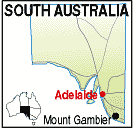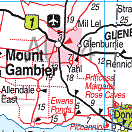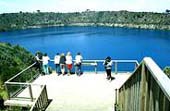|
There are many things to do in the city of Mount Gambier.
The South-east of South Australia is noted for the limestone caves and sink-holes which form the sub-structure. In Mount Gambier there are several, easily accessible examples of caves. The easiest to find is Cave Gardens, right in the centre of town in the park opposite the Post Office. This scenic area has been landscaped around the main cave which was the site of early development in the town after the Henty brothers arrived in 1841. It was at one time the water supply for the town and windlasses were used to draw water from the base. In the 1890's a beautification scheme saw the beginnings of the gardens, and in 1909 the rose-gardens were planted. The fountain in the park was constructed in 1884. Umpherston Cave, just east of the city on the Princes Highway, is named after James Umpherston, who arrived in 1860, and was a foundation member of the Show Society and lived on a property nearby. An interesting display on the steps leading into the cave explains its colourful history, and a Mack logging truck and an old bull-dozer are among logging displays in the beautiful gardens surrounding it. Engelbrecht cave on Jubilee Highway West, is open to the public. It is actually a sink-hole used by divers. Guided tours operate and tour times can be obtained from the Lady Nelson Information Centre. Phone: 08 87241730. In Mount Gambier a visit to the Old Courthouse is well worthwhile. The building is now a museum and group enactments of trials can sometimes be seen. Opened in January 1865, and used until 1975. it became an acquisition of the National Trust. There are old photographs of Mount Gambier, police and court records, and other historic displays. The museum is in Bay Rd, on the way to the Blue Lake. The Blue Lake is one of the world's phenomenum. It inexplicably changes colour from a drab grey to a brilliant torquoise each September to March. Tours of the lake and the pumping station can be arranged through motels or the Information Centre. Mount Gambier is also famous for its dairy produce. Rich and generous pastoral land around the town is perfect for the production of high quality cheeses and other produce, These can be sampled and purchased at several outlets in the city and provide a pleasant reminder of your visit. The main one is Yoey's in Commercial St. East. and off the Penola Rd. North of town, is the Mil Lel factory. Opening times can be obtained from the Lady Nelson Information Centre. Attamurra Cottage, on Attamurra Rd. leading to the golf course, has a display of characters made by Louise and Kelmyn, and a shop packed with locally made souvenirs and crafts. There is also a glass-house of cacti and succulents to visit., The cottage was a tourism award winner in 1991. Other places to visit include the Lewis Museum in Pick Ave. which houses extensive displays of memorabilia, the Vansittart Park Gardens at the corner of Commercial St. West and Wehl St and the Sir Robert Helpmann Theatre and Civic Centre behind the Cave Gardens. To get the most out of your visit to Mount Gambier call in to the Lady Nelson Information Centre on Jubilee Highway East where you will receive a warm welcome. There are lots of things to see and do in and around Mount Gambier. A list of these and accommodation will be found below. A BRIEF HISTORY OF MOUNT GAMBIER Mount Gambier was named after James Gambier, Lieutenant Governor at New Province in the Bahamas. He joined the R.N. aged 11, reached Post-Captain at 22 and Rear Admiral at 39. In 1802 he became Governor of Newfoundland and in 1807, Lord Gambier. He died in 1833 aged 76. In June 1839 Stephen Henty, a pioneer of Portland, Vic saw Mt Gambier and the lake, climbed it, and described it as "..a sight I can never forget.". Around 1840 he returned with a small party and built 2 huts on a 'squat', one at Valley Lake and one near Cave Gardens. soon others arrived and one, the brother of explorer Charles Sturt, Evelyn, took a lease over property which included Henty's 'squat', thus forcing him of his pioneer claim. Over the next decade a steady stream of settlers arrived, mostly from Tasmania, Victoria and Adelaide. By 1860 there were some 2,000 people and the first Government land sale was held. PLACES OF INTEREST: PLACES TO VISIT ATTRACTIONS AROUND MOUNT GAMBIER ACCOMMODATION & SERVICES: 
|

|
© Copyright Peter W. Wilkins 2008 | |



